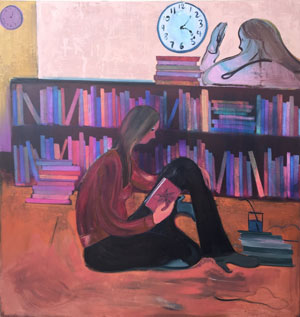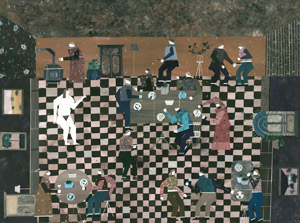Reaching for You
John Haberin New York City
Ellen Berkenblit and Images of Women
Heidi Hahn and Andrea Joyce Heimer
Ellen Berkenblit brings her defiance to women, horses, and color fields. If you are reaching out to art, she is reaching out to you. Heidi Hahn may seem instead to be lamenting you, and flatness might describe her mood as well as her fields of color. Yet she, too, insists that women define their public and private image. So does Andrea Joyce Heimer, caught between ancient art, a social scene, and her anxieties about both.
Horses or women?
Ellen Berkenblit makes you step back, only to wonder what you missed. You step back from big canvases, big colors, and plenty of black. You step back from a horse rearing in profile in the darkness, lest it trample you, or an umbrella in a cage, lest it poke you in the face.  You step back from a bulbous foot and ankle with a single toe, lest it kick you somewhere even more vulnerable. You step back from a hand plucking a flower, as Tincture of Musk, to avoid the smell. Besides, those archly curved fingers with their red nail polish could instead be reaching for you.
You step back from a bulbous foot and ankle with a single toe, lest it kick you somewhere even more vulnerable. You step back from a hand plucking a flower, as Tincture of Musk, to avoid the smell. Besides, those archly curved fingers with their red nail polish could instead be reaching for you.
Berkenblit is always in your face, and the greater part of you might like it that way. You might even wish that she were reaching for you. She paints pleasures and temptations, with a small cast that boils down to just that horse and just that woman, as obvious projections of the artist. She means them to project a long way. You do not step back as you would for the majestic symmetry of an abstraction by Jackson Pollock, say, or the busy allegories of Paolo Veronese in the Renaissance, but rather for the comic energy of a pointy nose out a graphic novel. Just bear in mind that she may be laughing at you.
You may not find it so easy to laugh along with her. More often, the horse looks slightly down and slightly sad, but still larger the life. The woman appears at her most confident striding across and into the canvas, past still more flowers, wearing only a velvet ribbon around her neck. The horse faces an American flag with colors wildly at odds with reality, and the woman's skin is a peculiar shade of violet. The colors could be unsettling the painting or you. Berkenblit works in layers and gestures, with a brush or palette knife. Those blacks may combine colors, bright colors may have warmer underpainting, and hard edges may dissolve halfway into shadow.
The comic-strip outlines and surfeit of flesh are heirs to Carroll Dunham, although with more attention to painting. They have just as much to do with the characters bordering on abstraction common to art right now, although never quite as slippery. They do not inhabit the anxious allegories of Dana Schutz or the enigmatic interiors of Patricia Treib. They may look to Henri Matisse for their large fields of color, but without the classicism. They are just too concerned for sensuality. Berkenblit may paint over charcoal or over calico, ever mindful of what she exposes or effaces.
When it comes to sex, you may miss the irony of Eric Fischl, the sheer madness of Carol Rama or Marilyn Minter before him, the trickery of Aneta Grzeszykowska, the frankness of Clarity Haynes, or a more self-conscious feminism. Berkenblit can seem by comparison way too obvious and a little too self-involved. She is, though, always a painter and never quite what she seems. A title like I Don't Object If You Call Collect could be rapping or indulgent. A title for the striding woman, V, could announce victory or just plain drawing. She really could be reaching for you.
Just upstairs, Nicole Eisenman puts flesh on the line as well—and with much the same comic crudity. Eisenman has made brutal free-standing sculpture and more leisurely drawing, but she has a greater reputation for mask-like faces in paint. Here she works between the two, in wall reliefs and related works on paper. They run the gamut of expressions and assemblages. Yet their roots in pop culture and found imagery are hard to pin down. They exist for that tempting space in between.
Here, now, and elsewhere
Heidi Hahn has seen better days, but it is hard to say when. Meantime, her women just do the best they can. They read, check the phone yet again, or even paint. They hang out together without paying one another the least attention, as roommates do by necessity—especially those with smartphones. They try to get some rest or to get off the floor, beneath a clock that is right at least twice a day. They take insistent walks even in the rain.
They seem, in short, not terribly good at taking care of themselves, but who knows? The rain seems to miss them entirely, even if they cannot manage an umbrella. It could interfere with their determined stride. Sometimes the sun comes out at that, and the showers bring a flower, just as in the proverbs and promises. It is a lone and rather schematic flower, much like the lone and schematic women, and the walker acknowledges it no more than the cloud, but why should she? Hahn has looked inward to discover both.
She, too, is just going about her business whatever her mood, like Rachel Feinstein as "maiden," "mother," and "crone." She calls the series The Future Is Elsewhere (If It Breaks Your Heart), but she sticks to the here and now. The title sticks to the vernacular as well, with the deeply felt illogic of many a song. Hahn's past shows have spoken of sadness, uncertain love, and looking to herself for raw experience, with what could pass for still more song titles. They have also had swirling colors and crowds out of a nightmare or dark ritual. Here she sets aside the otherworldly and the overstatement in search of the personal and the everyday.
She does so, though, with anything but everyday colors. Her silhouettes run to deep pinks and purples, face down or in profiles that flatten them all the more. She also hides their faces, with a loss of individuality that could stand for generalization or pain. The style is duly expressive, a bit like German Expressionism, but closer still to the passion of Paul Gauguin in Brittany. He, too, sought the future and an elsewhere, and he, too, had mixed feelings about the female body. Like Hahn, he found it ever so sensual but also something of a burden.
It shows in his fields of color. Their flattening can make them iconic or disembodied. (Historians have looked to their "primitivism" for a greater sensuality, but also for a French Catholic education and a revulsion at the flesh.) The urgent questions also appear in his most epic painting after his move to Tahiti: Where Do We Come From? What Are We? Where Are We Going? Its many women could represent the course of a single lifetime, much as Hahn's social gatherings might be a gathering of one.
Her fields of color bring the work alive, just as for him, William Copley, or Kyle Staver today, but with a subtle difference. Gauguin sometimes ironed his oils to flatten them further, but Hahn is not hiding her textures and her brushwork. (Then again, could Gauguin's ironing create scars like these?) She also leaves in place the thickening from paint drops, to lend her forms their structure and fluidity. Hahn leaves their clothes on as well. They can get sentimental, like many a pop song, but she owns them and owns up.
Not a toga party
Did you ever think that you would like ancient art a lot more if it could throw a decent party? Andrea Joyce Heimer is here to help. Her paintings give preclassical nudes an active social life. It may even look like one you know. They can still seem obsessed with raw power, and they still cannot be bothered to dress for the occasion. But then this was all a long time ago.
 Just how long ago? Heimer is not saying. The figures may look Mycenaean rather than heroic only because she also adopts the awkwardness of folk art. Her forests and interiors stay almost entirely within the picture plane, with vegetation and floor tiles climbing vertically rather than receding. She also brings the exuberance of Pattern and Decoration, in mute but memorable colors. One could well forgive the nudes for strutting their stuff.
Just how long ago? Heimer is not saying. The figures may look Mycenaean rather than heroic only because she also adopts the awkwardness of folk art. Her forests and interiors stay almost entirely within the picture plane, with vegetation and floor tiles climbing vertically rather than receding. She also brings the exuberance of Pattern and Decoration, in mute but memorable colors. One could well forgive the nudes for strutting their stuff.
She brings them closer to the present, in downright fashionable gardens and living rooms. The tiling could almost be showing off floor samples for a coming renovation, with a wash that allows it to vibrate. They tend to a very nice dog on the rug and socialize quite well, thank you. Often enough, the artist leaves their gender clearly female or a tad ambiguous. She subjects figures from an ancient vase to the feminist revolution. If some still hunt one another or bind their victims, well, men can be pathetic.
So, alas, can women. Heimer accompanies each painting with wall text, its faint pencil and block capitals a further testimony to damaged feelings. It runs to self-accusation but also to poetry. "I got so angry that I ruined everything." It also reaches out to you. "If I did not find you, will I always live in a world of ghosts?"
The women from Danielle Orchard a floor apart live among ghosts, too. Mostly paired and only barely interacting, they seem unable to get dressed after checking their cell phones or a bath. They have much in common with Hahn's languor at the same galley a year before, although without her fluent drawing and ambiguous feelings. They seem a little too concerned for nudity at that, for all their ingenious spaces and sharp colors, with echoes of Cubism and German Expressionism. They never do quite drag themselves into a recognizable past or present. That is where Heimer comes in.
"What if I was welcomed in this house," another caption or title begins, "and made a part of the work?" A social occasion already suggests a welcome, and the flatness, outsider status, partying, and sophistication all have an ancestor in Florine Stettheimer—who, socially and financially, did have it made. Heimer, as yet, does not. "Then I stand, thick and lost, a little white statuette in a crowded room." Then again, even antiquities can come to life.

Ellen Berkenblit and Nicole Eisenman ran at Anton Kern through July 6, 2017, Heidi Hahn at Jack Hanley through November 12. Andrea Joyce Heimer ran at Nicelle Beauchene and Danielle Orchard at Hanley, both through March 11, 2018.




